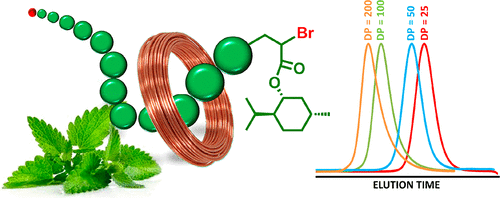当前位置:
X-MOL 学术
›
Biomacromolecules
›
论文详情
Our official English website, www.x-mol.net, welcomes your
feedback! (Note: you will need to create a separate account there.)
SET-LRP of the Hydrophobic Biobased Menthyl Acrylate
Biomacromolecules ( IF 5.5 ) Pub Date : 2018-03-07 00:00:00 , DOI: 10.1021/acs.biomac.8b00090 Nabil Bensabeh 1 , Joan C. Ronda 1 , Marina Galià 1 , Virginia Cádiz 1 , Gerard Lligadas 1, 2 , Virgil Percec 2
Biomacromolecules ( IF 5.5 ) Pub Date : 2018-03-07 00:00:00 , DOI: 10.1021/acs.biomac.8b00090 Nabil Bensabeh 1 , Joan C. Ronda 1 , Marina Galià 1 , Virginia Cádiz 1 , Gerard Lligadas 1, 2 , Virgil Percec 2
Affiliation

|
Cu(0) wire-catalyzed single electron transfer–living radical polymerization (SET-LRP) of (−)-menthyl acrylate, a biobased hydrophobic monomer, was investigated at 25 °C in ethanol, isopropanol, ethyl lactate, 2,2,2-trifluoroethanol (TFE), and 2,2,3,3-tetrafluoropropanol (TFP). All solvents are known to promote, in the presence of N ligands, the mechanistically required self-regulated disproportionation of Cu(I)Br into Cu(0) and Cu(II)Br2. Both fluorinated alcohols brought out their characteristics of universal SET-LRP solvents and showed the proper polarity balance to mediate an efficient polymerization of this bulky and hydrophobic monomer. Together with the secondary alkyl halide initiator, methyl 2-bromopropionate (MBP), and the tris(2-dimethylaminoethyl)amine (Me6-TREN) ligand, TFE and TPF mediated an efficient SET-LRP of MnA at room temperature that proceeds through a self-generated biphasic system. The results presented here demonstrate that Cu(0) wire-catalyzed SET-LRP can be used to target polyMnA with different block lengths and narrow molecular weight distribution at room temperature. Indeed, the use of a combination of techniques that include GPC, 1H NMR, MALDI-TOF MS performed before and after thioetherification of bromine terminus via “thio–bromo” click chemistry, and in situ reinitiation copolymerization experiments supports the near perfect chain end functionality of the synthesized biobased hydrophobic polymers. These results expand the possibilities of SET-LRP into the area of renewable resources where hydrophobic compounds are widespread.
中文翻译:

疏水性生物基丙烯酸甲酯的SET-LRP
(25)在乙醇,异丙醇,乳酸乙酯,2,2, 2-三氟乙醇(TFE)和2,2,3,3-四氟丙醇(TFP)。已知所有溶剂都会在存在N配体的情况下促进机理上需要的自调控的Cu(I)Br自我歧化成Cu(0)和Cu(II)Br 2的歧化。两种氟化醇都展现出通用SET-LRP溶剂的特性,并显示出适当的极性平衡,以介导这种庞大且疏水的单体的有效聚合。与仲烷基卤化物引发剂,2-溴丙酸甲酯(MBP)和三(2-二甲基氨基乙基)胺(Me 6-TREN)配体,TFE和TPF在室温下介导了通过自生双相系统进行的MnA的高效SET-LRP。此处显示的结果表明,Cu(0)线催化的SET-LRP可用于靶向具有不同嵌段长度和室温下较窄分子量分布的聚MnA。确实,结合使用包括GPC,1 H NMR,MALDI-TOF MS在内的多种技术,通过“硫代-溴”点击化学方法在溴末端进行硫醚化之前和之后进行了原位合成重新引发共聚实验支持合成的生物基疏水性聚合物的近乎完美的链端官能度。这些结果将SET-LRP的可能性扩展到了疏水性化合物广泛的可再生资源领域。
更新日期:2018-03-07
中文翻译:

疏水性生物基丙烯酸甲酯的SET-LRP
(25)在乙醇,异丙醇,乳酸乙酯,2,2, 2-三氟乙醇(TFE)和2,2,3,3-四氟丙醇(TFP)。已知所有溶剂都会在存在N配体的情况下促进机理上需要的自调控的Cu(I)Br自我歧化成Cu(0)和Cu(II)Br 2的歧化。两种氟化醇都展现出通用SET-LRP溶剂的特性,并显示出适当的极性平衡,以介导这种庞大且疏水的单体的有效聚合。与仲烷基卤化物引发剂,2-溴丙酸甲酯(MBP)和三(2-二甲基氨基乙基)胺(Me 6-TREN)配体,TFE和TPF在室温下介导了通过自生双相系统进行的MnA的高效SET-LRP。此处显示的结果表明,Cu(0)线催化的SET-LRP可用于靶向具有不同嵌段长度和室温下较窄分子量分布的聚MnA。确实,结合使用包括GPC,1 H NMR,MALDI-TOF MS在内的多种技术,通过“硫代-溴”点击化学方法在溴末端进行硫醚化之前和之后进行了原位合成重新引发共聚实验支持合成的生物基疏水性聚合物的近乎完美的链端官能度。这些结果将SET-LRP的可能性扩展到了疏水性化合物广泛的可再生资源领域。









































 京公网安备 11010802027423号
京公网安备 11010802027423号